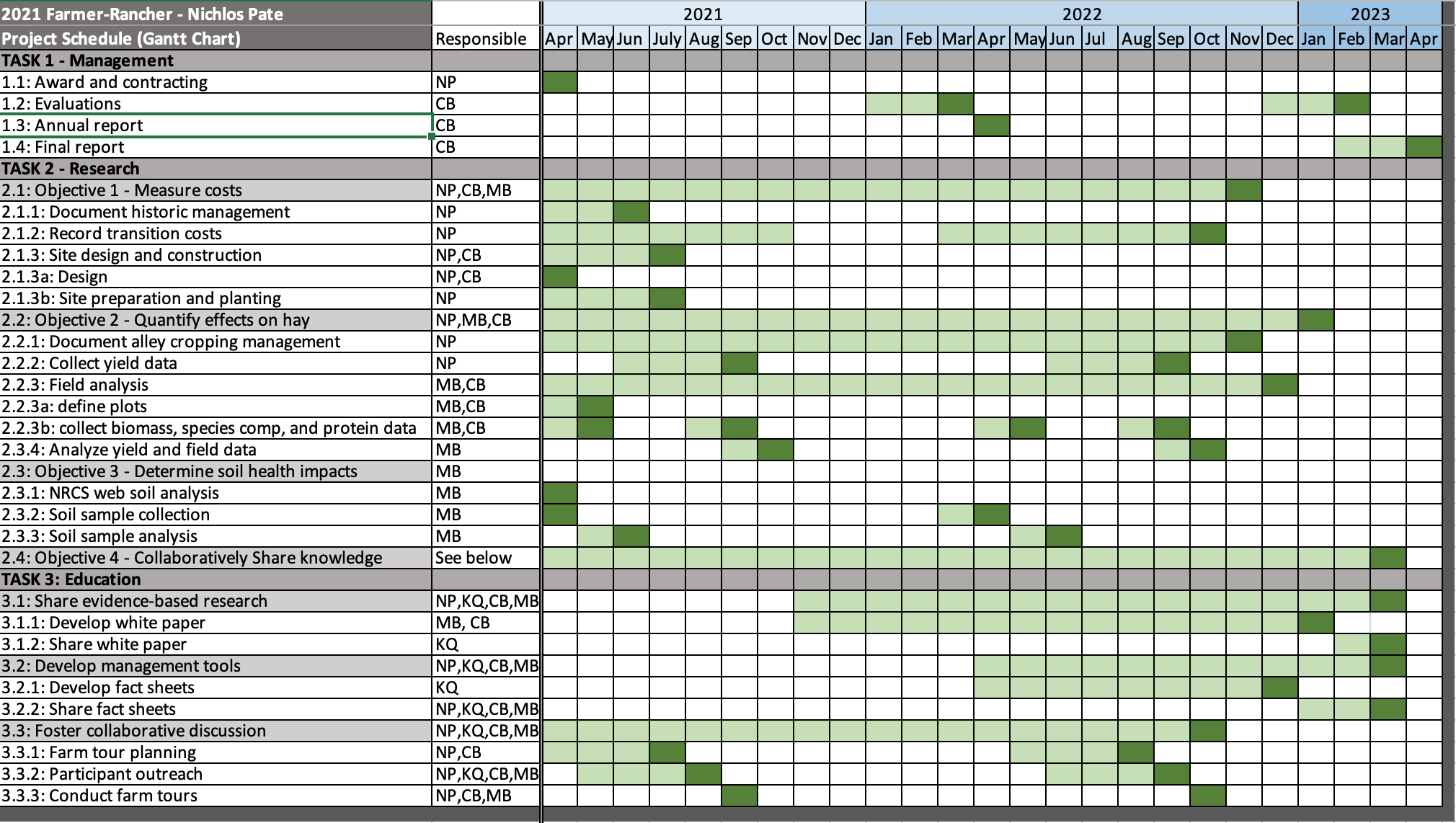Final report for FW21-374
Project Information
Very little information around the costs and benefits of agroforestry for production farmers in Western Washington exists. Studies from other areas of the country (Mungai, et al 2006; Garrett and McGraw, 2000) and anecdotal evidence suggest that applying alley cropping to hay production could improve soil ecology, reduce erosion, and reduce drought and flood risks (Schoeneberger, et al 2012). These benefits may also coincide with improved yields or nutritional value for primary crops (Wolz, 2017). However, without regionally specific information that addresses the challenges and benefits of adoption, agricultural professionals are unable to confidently recommend alley cropping as a best management practice (BMP), and producers are unlikely to adopt it. This project looks to address the research question of “What are the ecological and economic impacts of an apple/hay agroforestry system in Western Washington?”
This project will examine the costs of transitioning conventional hay production to a cider/hay alley cropping system, look at changes in hay yield and nutritional value, and examine the soil health/ecology changes to fields in alley cropping. The goal of answering this research question is to provide farmers interested in transitioning to agroforestry or incorporating tree crops into hay, as well as agricultural professionals, with essential cost-benefit information for decision making. By disseminating results through field days and web media, Snohomish Conservation District (SCD) and Washington State University (WSU) aim to provide local producers with a key BMP to address the threats of climate change, increase productivity, and improve the health of the agroecosystem.
Research Objectives
Objective 1: Measure the costs of establishing and managing a cider apple/hay alley cropping system
Objective 2: Quantify the effects of alley cropping on hay yields and quality
Objective 3: Determine soil health impacts of conversion to apple/hay alley cropping
Objective 4: Collaboratively share knowledge and results among current and potential producer practitioners, agricultural professionals, and scientists
Educational Objectives
- Share evidenced-based research on the agroecological and economic effects of alley cropping with farmers, agricultural professionals, and the general public.
-
Develop alley cropping farm planning and management tools for transitions to agroforestry systems
-
Foster collaborative discussion around agricultural resilience BMPs
Cooperators
- (Researcher)
- - Technical Advisor (Educator and Researcher)
- - Producer (Educator and Researcher)
- (Educator)
Research
Objective 1: Measure the costs of establishing and managing a cider apple/hay alley cropping system
Mr. Pate, with support from the research team, documented procedures used to convert hay pastures into an alley cropping agroforestry system. This data will be used as a metric for management decisions and will be used to disseminate information as a learning tool to other producers. Mr. Pate carried out economic calculations to generalize the financial and labor costs associated with this alley cropping system, including start-up and maintenance costs. These costs were compared with estimated gains produced by apple and hay production but this did not offer a good analysis of the financial potential of this system. One of the crop components of this system are apple trees. Within only two years of establishment we are unable to assess the potential of this system as trees are several years from reaching their production potential. However, information collected will serve as economic and ecological baseline in which future data will be comparatively analyzed.
Mr. Pate installed an apple/hay alley crop pasture in 2017 adjacent to the proposed new alley crop pasture. This previous establishment will allow the research team to collect soil, and management data on two age classes of alley cropping, broadening the scope and depth of this research project.
- Document management and previous management techniques. Mr Pate was able to record present hay yields and economic costs associated with hay production. Mr. Pate recorded this information to be used as an economic analysis tool for the establishment and maintenance of an alley cropping system.
- Record and document costs associated with the transition from a hay pasture to alley cropping fields. Costs were categorized by 1) supplies and equipment; 2) changes in labor. This information was recorded and made available to the rest of the research team.
- Alley cropping implementation will followed a design that will contain the following information:
- Costs of apple trees, root stock, and varieties of trees.
- Installation of trees: Labor, method of tree installation, timing, and comprehensive materials list and costs.
- Site preparation: mechanical, biological, and chemical methods used to modify alley crop pastures.
- Layout design: trees per acre, spacing between rows, spacing between trees.
- Site analysis- soil analysis (see objective 3), Soil type from Web Soil Survey (NRCS) and plant species composition
Analysis of data: Information collected from the data associated with this objective will be used as a managerial tool that will provide detailed information on conversion costs. Costs associated with labor and supplies will be comparatively analyzed to previous production costs.
Objective 2: Quantify the effects of alley cropping on hay yields and quality
Using the haymaking methods as laid out by Fransen and Hackett in the WSU extension bulletin ‘Haymaking on the Westside,’ Mr. Pate documented his management decisions including preparation, timing, and equipment used in hay harvest. Mr. Pate gathered yearly yield data from harvests in both alley cropping fields and the control hay pasture. This informed Mr. Pate of the influence of the alley cropping system on hay production and will help influence future management decisions including apple tree pruning techniques, mowing frequency, and timing of harvest. Yield data also highlighted economic impacts of the transition period of an alley cropping system and will influence further management goals and objectives.
In addition to management and yield data, Ms. Brausieck and Mr. Batcheler conducted an annual field analysis at the beginning of the growing season in the two alley cropping fields and control hay pasture, using a 1m2 quadrate and a farm map to specifying plot location. They quantified: 1) species composition 2) changes in OM ; 3) protein analysis of hay.
Results of this data will help influence management decisions for haymaking as well as determine the influence of apple trees on species composition of hay as the system matures.
Objective 3: Determine soil health impacts of conversion to apple/hay alley cropping
Mr. Batcheler conducted a comparative soil analysis between hay fields (control) and intercropped components of the alley cropping fields (experimental). Quantifying soil analyses will influence economic and ecological success for both apple and hay production. Temperate alley cropping systems may contribute to soil organic matter (SOM) content through addition of tree leaf litter, fine roots, and crop residues. As well, changes in microbial respiration and nutrient cycling can be influenced by the micro-climates created by tree canopies. We conducted three comparative analysis of the soil: 1) near the tree row; 2) in the middle of each alley cropped row; 3) within the control hay pasture.
Mr. Batcheler and Ms. Brausieck conducted a site analysis through the use of the Soil type from Web Soil Survey (NRCS).
At the beginning of each growing season (March-April), the research team took four soil samples at each of the three sites. Soil samples were taken at 10 inches of depth and approximately 10 meters from the edge of each site in order to reduce edge effects. Soil samples were taken at three different distances (3ft, 6ft and 9ft) from randomly selected trees in each orchard.
Soil samples were sent to Soiltest Farm Consultants Inc. This analysis included: CEC, OM, pH, available nutrients and total carbon
Data analysis: The results of soil analysis will inform the producer of changes in soil health as a result of agroforestry management implementation. Based on the results, Mr. Pate may be able to modify his fertilizer rates thus effecting economic returns and management decisions.
Objective 4: Collaboratively share knowledge and results among current and potential producer practitioners, agricultural professionals, and scientists
Closing current knowledge gaps in the farm community and in extension literature is perhaps the most important objective of our project. We hope to foster knowledge sharing and mentoring and to provide guidance for both producers and extension professionals who want to enhance the economic and ecological feasibility and sustainability of alley cropping practices. Our outreach features a combination of interactive field events, web communications, and a fact sheet publication.
Objective 1: Measure the costs of establishing and managing a cider apple/hay alley cropping system
Costs: Costs for establishing the 1 acre cider/hay alley cropping system:
Cider applies:
- $16/tree x 121 trees = $1,936
- Compost 5.5 yards = $178
- Calphos 200lbs = $122.08
- Tree states and protection tubes = $247.02
- Pea gravel = $83.39
Total $2,566.49
Soil tests were taken over the course of the two-year trial to tease out any impacts the installation of trees into the hay fields would have on soil.
Tests were taken before establishment, spring of the 1st year (2021) and spring of the 2nd year (2022). Samples were taken from an already established apple/hay alley cropping system, the newly established system, and a control field of hay only.
16 Soil tests over two years = $49.50/test = $792.00
Hay analysis was also done on the summer cutting of 2021 and the summer cutting of 2022. Samples were analyzed from the original alley cropping system, the newly established system and the control hay field. 6 feed analysis tests at $55/test = $330.00
Objective 2: Quantify the effects of alley cropping on hay yields and quality
Hay Yields:
In the second year, five pounds of Ananas Reinette and ten pounds of Dabinett were harvested in early October.
Hay yields in the control field were approximately six tons per year, while yields in alley cropping system averaged approximately three tons per year.
Hay Quality: To determine the impact of the alley cropping establishment and management on hay quality we initially planned to measure crude protein from randomly selected samples in the control and experimental plots. However it was determined that the hay in the orchards would be mowed multiple times in a growing season in order to ensure trees in the alley's could be managed. Multiple mowings in addition to fertilizers added to the trees could result in changes in nutrient content. Thus we opted for a broad wet chemical feed analysis to compare the following values: crude protein, acid detergent fiber (ADF) and neutral detergent fiber (NDF), relative feed value (RFV), digestible protein and macro and micro nutrient percentages (sulfur, phosphorous, potassium, calcium, magnesium, zinc, manganese, copper, iron, sodium and boron) We will utilize an analysis of variance to determine the variability of hay nutrient composition within the two experimental plots and between experimental and control plots once we have completed collecting samples from our second year.
Hay species composition: On September 7th, 2021 we collected the hay species composition in fields. Composition was uniform across the three fields: old alley cropping field, new alley cropping field, and control hay only field, with a few additional species found in the old alley cropping field. Species common across all fields are:
- tall fescue - Festuca arundinacea
- dandelion - Taraxacum officinale
- red clover - Trifolium pratense
- velvet grass - Holcus lanatus
- orchard grass - Dactylis glomerata
- Bent grass - Agrostis stolonifera
Additional species found in the old alley cropping field were as follows:
- common plantain - Plantago major
- buttercup - Ranunculus repens
- cat's ear - Hypochaeris radicata
- perennial ryegrass - Lolium perenne
Overall Hay Analysis
The crude protein in the 2018 hay samples was significantly higher than the 2021 alley cropping system and the hay field. In addition, both the 2018 and 2021 alley cropping systems had higher percentages of potassium when compared to the hay field. The increase in crude protein is likely due to the multiple cutting strategy and timing of the harvest. As the 2021 alley cropping system had been recently established in relationship to this study, it is likely that the change in hay management practices had yet to affect the crude protein levels in the hay. There are trade-offs when cutting hay early and often. While cutting hay using this method is likely to increase crude protein, it will lower yields.
Objective 3: Determine soil health impacts of conversion to apple/hay alley cropping
Using the NRCS soil web survey it was determined that the primary soil series is Puyallup fine sandy loam; a very deep, well-drained soil formed on stream terraces. Soil samples were collected in April in 2021 and 2022 at three different distances between tree rows to determine changes in soil nutrient content, pH, organic matter and cation exchange capacity.
After two years of data changes in soil pH, organic matter, micro and macro nutrients were compared between Raising Cane’s new 2021 alley cropping system, the control hay field, and their 2018 alley-cropping system. Soil pH was significantly higher in the 2018 alley cropping system when compared to the 2021 alley cropping system. Essential micro-nutrients were significantly higher in the hay field when compared to the 2018 alley cropping system. The apple trees in the 2018 system may be utilizing these micro-nutrients at higher rates due to the age of the trees and higher fruit production, however further research is needed to determine the cause. The only macro-nutrient that was significantly different was calcium, which was significantly lower in the 2021 alley cropping system when compared to the hay field and the 2018 alley cropping system.
Research Outcomes
Labor Investments
Site preparation in early March involved row layout and two hours for mowing. In mid-March, holes were dug with hand shovels and compost and Calphos were added to each hole. The trees were planted over three days, totaling 21 hours of labor.
The first spring cutting was done in May with a 60-inch deck mower at six inches. The second cutting was in July, and the final in late August. Cutting in the control hay field took 0.5 hour while cutting in the alley cropping system took 1.5 hours.
Tedding also took longer, requiring 1.5 hours in the control hay field and three hours in the alley cropping system.
Other labor investments included mowing in July and mid-September to control voles and grass competition with trees (two hours each), watering young trees with slurry in late August (1.5 hours in August and three hours in September, due to the extremely dry summer), and spreading manure in early October took approximately 2 hours.
Yields
In the second year, five pounds of Ananas Reinette and ten pounds of Dabinett were harvested in early October.
Hay yields in the control field were approximately six tons per year, while yields in alley cropping system averaged approximately three tons per year.
Soil Test Analysis
Changes in soil pH, organic matter, micro and macro nutrients were compared between Raising Cane’s new 2021 alley cropping system, the control hay field, and their 2018 alley-cropping system. Soil pH was significantly higher in the 2018 alley cropping system when compared to the 2021 alley cropping system. Essential micro-nutrients were significantly higher in the hay field when compared to the 2018 alley cropping system. The apple trees in the 2018 system may be utilizing these micro-nutrients at higher rates due to the age of the trees and higher fruit production, however further research is needed to determine the cause. The only macro-nutrient that was significantly different was calcium, which was significantly lower in the 2021 alley cropping system when compared to the hay field and the 2018 alley cropping system.
Hay Analysis
The crude protein in the 2018 hay samples was significantly higher than the 2021 alley cropping system and the hay field. In addition, both the 2018 and 2021 alley cropping systems had higher percentages of potassium when compared to the hay field. The increase in crude protein is likely due to the multiple cutting strategy and timing of the harvest. As the 2021 alley cropping system had been recently established in relationship to this study, it is likely that the change in hay management practices had yet to affect the crude protein levels in the hay. There are trade-offs when cutting hay early and often. While cutting hay using this method is likely to increase crude protein, it will lower yields.
Labor and costs
Most of the labor and cost for this system is in the first year of transition and establishment. Costs and labor can be offset through various sources of grant funding.
In this new system it was found that the time to harvest hay doubled while the yields were cut in half. Apple trees reach full production between 5 to 8 years of maturity, so the yields in apples will not make up for the reduction of hay yields for the first few years. Once trees reach full production fruit yields may bring in more value than what is lost in hay. More data, over a longer timeframe, would need to be collected to quantify this.
Soil and Hay Analysis
Of the different systems analyzed there were not a lot of significant differences among the three systems in the soils. The most significant differences may be due to different levels of use of multiple cuttings of hay and harvest time. As the hay was cut several times during the growing season to allow for ease of management of the apple trees, the crude protein will increase if the hay is harvested at an early stage. In addition, while crude protein may increase because of frequent cutting and early harvests, the result will also decrease yields. Care and consideration are paramount when using this method. Soil compaction will increase as result of the increase in use of heavy equipment. When possible, waiting to cut hay until soil has moisture decreased is beneficial to preventing compaction. Monitoring soils for increased soil compaction should be conducted on a yearly basis.
Climate Variability
The two years of this trial saw very different weather patterns than are typical for the region. The farm experienced extremely wet winters and long, cold, wet springs with an abrupt transition to greater than usual heat and long dry summers and autumns.
This variability in the weather led to stress on the new trees with a loss of 6 trees from standing water and clear signs of heat stress during the summer. In 2022 fruit production was cut by more than half throughout the entire farm due to climate variability. A reduction in hay productivity is also attributed to a lack of rain and not solely on the transition to alley cropping.
Hay within the alley cropping systems was more resilient to the climate extremes and was noticeably greener, more diverse, and of higher density. The increased quality of hay within the alley cropping system is likely due at this stage to the increased management of the overall system with more mulching and watering occurring within the system as opposed to the hay only fields.
Layout & Design
The layout of this system created some challenges. The efficiency of labor and management may have benefited from wider alley spacing to allow for more room for haying and mowing equipment. The current layout is tight, and it is hard not to hit trees with equipment. Wider, mulched or underplanted rows may have cut down on vole pressure and allowed space for foot traffic outside of hay production. Current spacing impacts hay harvest when managing trees.
This system was intentionally installed as an expansion of an existing apple/hay alley cropping system on the farm. The intentional expansion of this practice was due to a desire to diversify and transition the farm from a beef/hay dominant production system to a fruit production system. While this transition has presented challenges to managing multiple layers of crops and has not yet realized its full production value Raising Cane Ranch sees this as a valid and workable alternative to a more sustainable and resilient way of farming.
Education and Outreach
Participation Summary:
Outreach Completed:
1 Fact sheet has been developed summarizing the overall costs and outcomes of the project. This fact sheet will serve as a tool for other farmers to give them baseline information and anticipated costs for transitioning hay systems into alley cropping in Western WA.
Farm Tour 1
On September 27th, 2021 from 3 to 6pm we had a wonderful farm tour at Raising Cane Ranch to introduce agroforestry and to discuss the following topics with attendees:
What is agroforestry and what are its potentials as a land use (presented by Carrie Brausieck, Agroforester SCD)
Experience of transitioning to an agroforestry system of alley cropping cider apples and hay (Presented by Nick Pate, Farmer Raising Cane Ranch)
The research we are conducting and data collection (Presented by Mark Batcheler, WSU PhD student)
We all toured the farm and walked through the alley cropping systems. There were a lot of great questions and after our farm walk Farmer Nick served some of his wonderful hard cider to attendees for tasting!
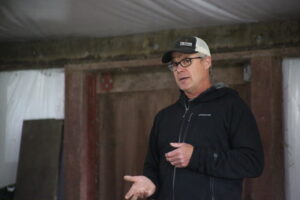
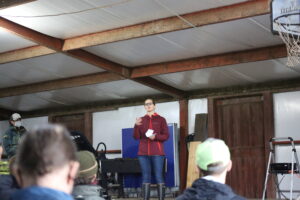
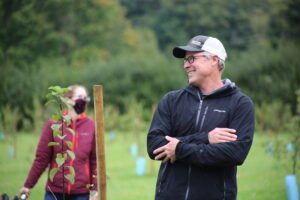
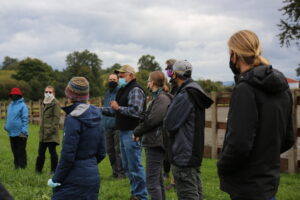
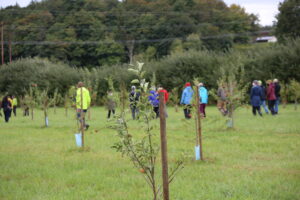
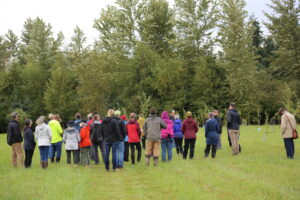 Agroforestry Farm Tour - Compressed - Sept 27 2021
Agroforestry Farm Tour - Compressed - Sept 27 2021
Farm Tour 2
On September 29th, 2022 from 2 to 5pm we had a wonderful farm tour at Raising Cane Ranch to introduce agroforestry and specifically alley cropping to attendees
We first held a panel discussion with the farmer of Raising Cane Ranch, Nick Pate, WSU Researcher, Mark Batcheler, and SCD Agroforester, Carrie Brausieck.
Topics covered were:
Why did you choose agroforestry as a profession or choose to implement agroforestry on your farm?
What are the challenges in establishing agroforestry in Western WA?
What are the successes and opportunities for agroforestry in Western WA?
What are we finding out from the establishment of this alley cropping system at Raising Cane Ranch?
We all toured the farm and walked through the alley cropping systems. There were a lot of great questions and after our farm walk Farmer Nick served some of his wonderful hard cider to attendees for tasting!
Two tours were conducted during the course of this grant funding.
The first was conducted on Monday, September 27th, 2021 from 3-5pm. This event was well attended by 25 local farmers and landowners. Snohomish Conservation District Staff gave presentations on agroforestry and alley cropping and Nick Pate gave a presentation on the establishment of his alley cropping system and why he chose to engage with agroforestry as a way of farming. A farm walk followed by a cider tasting from the farm’s own cidery.
The second tour was conducted on Monday, September 29th, 2022 from 2-4pm. This event was well attended by 31 farmers, college students, and agency staff. A panel discussion between the farmer, a Washington State University agroforestry research student, and the Snohomish Conservation District Agroforester was done to discuss challenges and opportunities for agroforestry in WA State. The discussion was followed by a farm walk and cider from the farm’s own cidery. Video was taken of the panel discussion and will be edited into a video that will be shared on social media, on the farm’s website and on the Snohomish Conservation District website.
Both tours kept the audience engaged and those in attendance asked lots of great questions and gave wonderful feedback about their experience. A total of 56 farmers, landowners, and agency staff were engaged in tours.
A fact sheet was developed to provide experience and information to other farmers interested in alley cropping in Western WA. This fact sheet will be shared on the farm’s website and on the Snohomish Conservation District website on the Agroforestry Program page.
